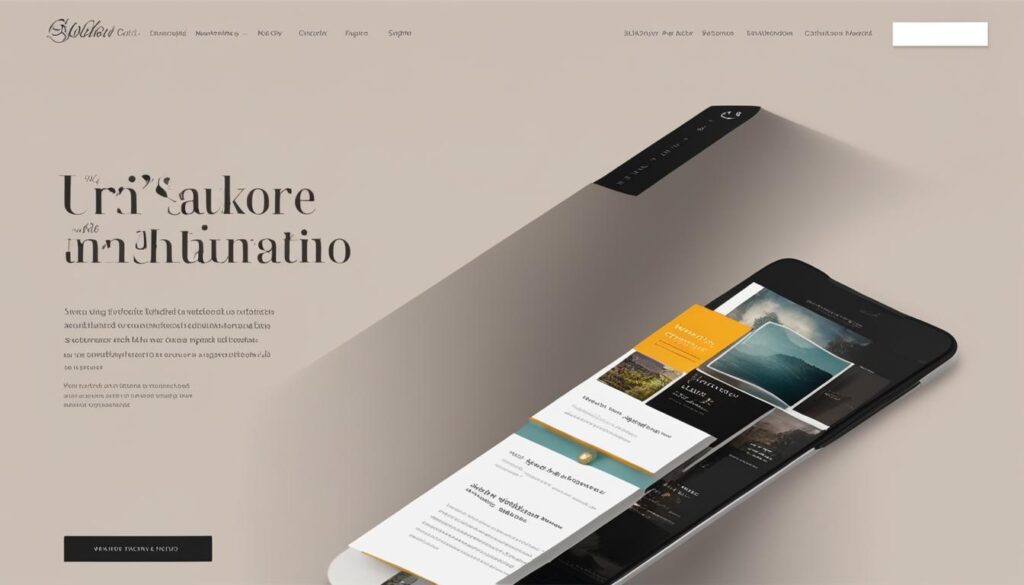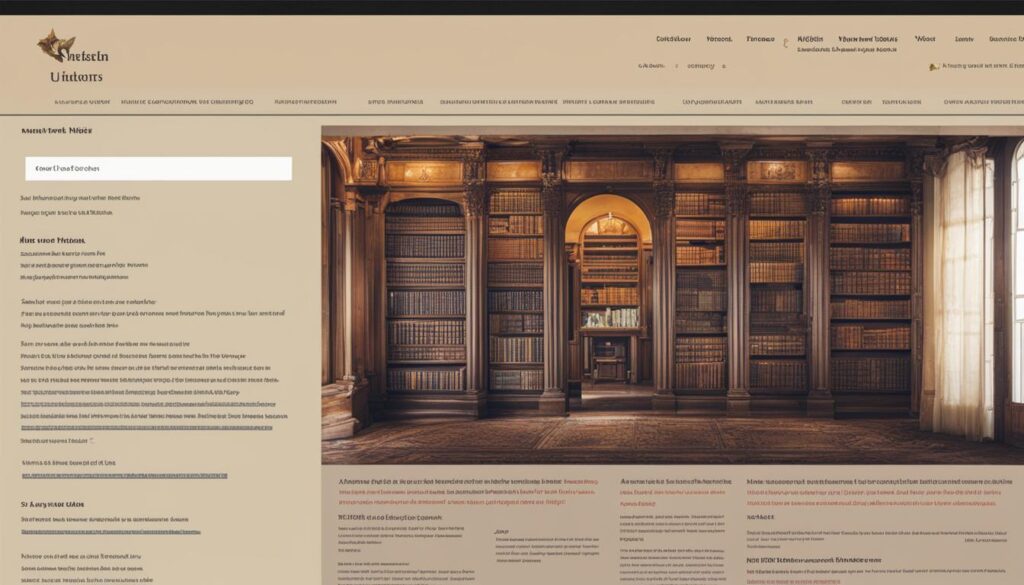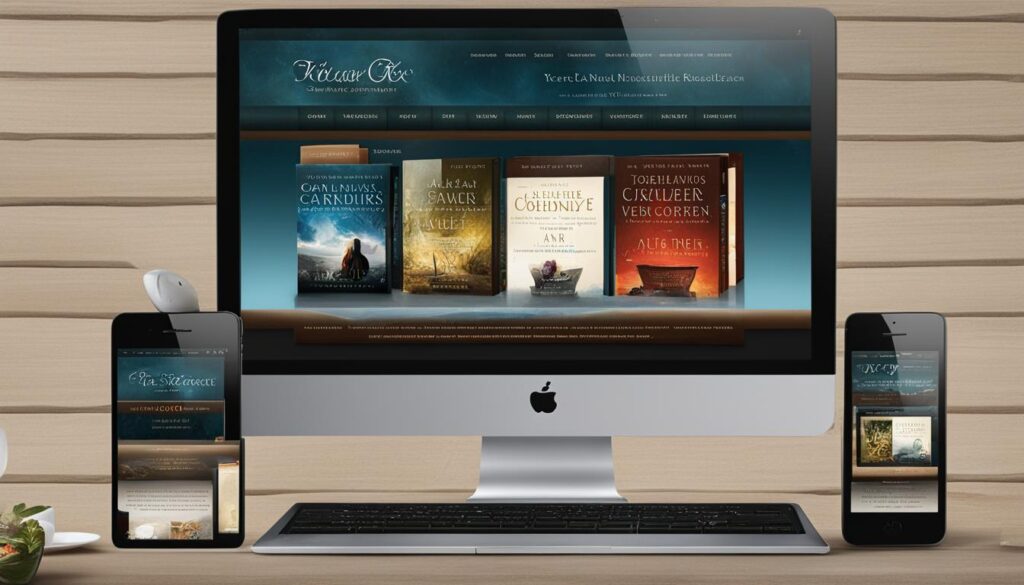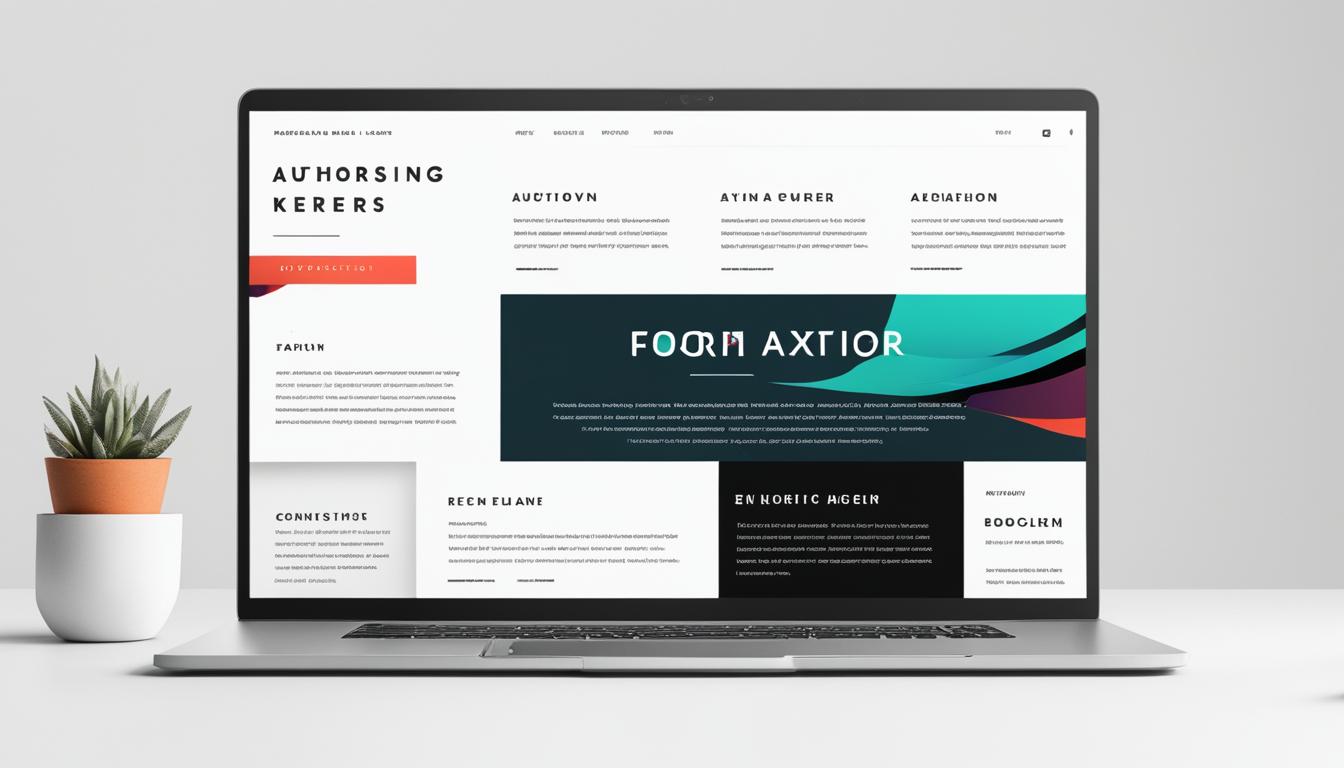As authors, we understand the importance of establishing our online presence and connecting with our readers. One powerful tool that can help us achieve this is a well-designed author website. In this article, we will guide you through the process of creating an effective author website that showcases your brand and works, and ultimately helps you succeed in your writing career.
Having a website is not just a luxury; it is a necessity for both self-published and traditionally published authors. It serves as our home base, where readers can learn more about us, our books, and our writing journey. An author website is the perfect platform to build an audience, sell more books, and engage with our readers on a deeper level.
Creating an author website may seem daunting, but fear not! We will walk you through each step of the process, from choosing a domain name and web hosting service to designing the layout and adding engaging content. With the right guidance, you will be able to create a website that not only reflects your unique brand but also captivates your target audience.
Key Takeaways:
- An author website is essential for establishing your online presence and connecting with readers.
- Having a website is necessary for both self-published and traditionally published authors.
- Creating an author website involves choosing a domain name, web hosting service, and designing a layout.
- An effective author website should include strong personal branding, an author bio, a blog, lead capture tools, a list of works, mobile functionality, and social media integration.
- Best practices for author website design include responsive design, user-friendly navigation, high-quality visuals, and search engine optimization.
Why Authors Need a Website
Having a website is essential for authors, whether they are self-published or traditionally published. A website serves as the central hub where readers can learn more about the author and their works. It provides a platform to showcase their writing, establish their brand, and connect with their target audience.
Building an author website offers numerous benefits for authors looking to promote their books and engage with readers. With a well-designed website, authors can:
- Showcase their books: An author website allows authors to display their books and provide detailed information about each publication. This helps to generate interest and attract potential readers.
- Connect with readers: By providing a direct channel of communication, an author website allows authors to connect with their readers on a personal level. They can engage in conversations, answer questions, and build a loyal fan base.
- Establish credibility: A professional website enhances an author’s credibility and professionalism. It demonstrates their commitment to their craft and shows that they take their writing seriously.
- Expand their audience: An author website acts as a marketing tool to reach a wider audience. It allows authors to share their work, blog about their writing process, and attract new readers who may be interested in their genre or subject matter.
- Sell more books: A well-designed website can significantly impact book sales. Authors can include links to online retailers or set up their own e-commerce platform to sell directly to readers, increasing their revenue.
“An author website is like a virtual storefront, open 24/7, ready to welcome readers and showcase your literary world.” – Jane Smith, Author Web Design Expert
Investing in professional author web design services can help authors create a visually appealing and user-friendly website that reflects their brand and engages their audience. With a well-designed website, authors can effectively promote their books, connect with readers, and establish a strong online presence.
Next, we will explore the process of creating an author website, sharing key elements, best practices, and inspiring case studies of successful author website designs.
| Benefits of Having an Author Website | |
|---|---|
| Showcase books and attract potential readers | |
| Connect with readers on a personal level | |
| Establish credibility and professionalism | |
| Expand their audience and reach new readers | |
| Sell more books and increase revenue |
Creating an Author Website

Building a professional author website is an exciting endeavor that allows you to showcase your writing and connect with your audience. In this section, we will guide you through the process of creating your own author website, step by step. From selecting a domain name and web hosting service to designing a captivating layout and adding engaging content, we have got you covered.
1. Choosing a Domain Name
The first step in creating your author website is selecting a domain name. Your domain name should be unique, memorable, and relevant to your writing brand. Consider using your author name or a variation of it to maintain consistency and brand recognition. For example, if your name is Jane Smith, you could choose a domain like www.janesmithauthor.com.
2. Selecting a Web Hosting Service
After choosing a domain name, the next step is to select a reliable web hosting service. A web hosting service stores your website’s files and makes them accessible to visitors. Look for a hosting provider that offers excellent uptime, fast loading speeds, and responsive customer support. Popular options include Bluehost, SiteGround, and HostGator.
3. Designing the Layout
The layout of your author website plays a crucial role in attracting and engaging visitors. Consider a clean and intuitive design that reflects your writing style and personality. Opt for a responsive design that adapts to different devices, ensuring a seamless experience for mobile users. You can choose from pre-designed website themes or hire a professional web designer for a custom look that aligns with your brand.
4. Adding Engaging Content
Once you have the basic structure of your website in place, it’s time to focus on adding compelling content. Craft a captivating author bio that highlights your writing journey, achievements, and unique selling proposition. Include a photo of yourself to personalize the experience for your readers. Additionally, consider adding a blog section where you can share updates, writing insights, and behind-the-scenes stories.
5. Integrating Social Media
Don’t miss out on the opportunity to expand your online presence by integrating social media platforms with your author website. Add social media icons that link to your profiles, allowing visitors to connect with you on platforms like Facebook, Twitter, or Instagram. This not only helps you engage with your audience but also boosts your website’s reach and credibility.
Creating an author website is an exciting and rewarding process that helps you build your author brand and connect with your readers. By following these steps and investing time and effort, you can create a visually appealing and user-friendly website that showcases your writing talent and attracts a loyal audience.
Key Elements of an Author Website
In order to create an effective author website, it is important to include key elements that will enhance your online presence, engage readers, and promote your brand. Here are the essential components that should be incorporated into your custom author website design:
1. Strong Personal Branding
Establishing a strong personal branding on your author website is crucial for making a lasting impression on visitors. This includes choosing a unique color scheme, selecting high-quality images that reflect your writing style and genre, and creating a consistent visual identity throughout your website.
2. Author Bio
Your author bio is your chance to introduce yourself to readers and showcase your writing achievements. It should provide a brief overview of your background, writing journey, and notable works. Including a professional headshot adds a personal touch and helps readers connect with you on a deeper level.
3. Blog
A blog allows you to regularly share updates, insights, and valuable content with your audience. It is a valuable tool for engaging readers, building a loyal fan base, and establishing yourself as an authority in your niche.
4. Lead Capture Tools
One of the primary goals of an author website is to capture leads and build an email list. Including visually appealing email sign-up forms at strategic locations on your website can significantly increase your subscriber base and allow you to communicate directly with your readers.
5. Book Marketing and List of Works
Featuring your published works on your website is essential for showcasing your accomplishments and generating interest among potential readers. Including book covers, summaries, and links to online marketplaces where your books can be purchased can drive sales and increase your fan base.
6. Mobile Functionality
In today’s mobile-centric world, it is crucial for your author website to be fully functional and visually appealing on all device types, including smartphones and tablets. Responsive design ensures a seamless browsing experience for visitors and allows them to access your content on the go.
7. Contact Forms
Make it easy for readers, media professionals, or potential collaborators to get in touch with you by including contact forms on your website. This allows for direct communication and opens up opportunities for networking, speaking engagements, and other professional collaborations.
8. Social Media Links
Connect your author website with your social media profiles to expand your reach and increase engagement. Including links to platforms such as Facebook, Twitter, Instagram, and Goodreads encourages readers to connect with you on multiple channels and stay up to date with your latest news.
9. Discussion/Comment Portals
Encourage reader interaction and foster a sense of community by including discussion or comment portals on your website. This allows readers to leave feedback, ask questions, and engage in conversations with you and other fans.
By incorporating these key elements into your custom author website design, you can create a compelling online platform that captivates readers, strengthens your brand, and drives book sales.
Best Practices for Author Website Design
Designing an author website requires careful consideration to ensure it is engaging, user-friendly, and optimized for success. Here are some best practices and tips to help you create a professional web design that captivates your audience and promotes your brand effectively.
1. Responsive Design
Responsive design is crucial for author websites as it allows your site to adapt to different screen sizes and devices, ensuring a seamless user experience. With the increasing use of smartphones and tablets, it’s essential to prioritize mobile responsiveness to reach a wider audience and keep readers engaged. Make sure your website layout, images, and text are optimized for various screen sizes and resolutions.
2. User-Friendly Navigation
Easy navigation is key to providing a positive user experience on your author website. Create a clear and intuitive menu structure that helps visitors find the information they are looking for quickly. Use descriptive labels for menu items and include a search bar for easy access to specific content. Avoid cluttering your website with too many menu options and prioritize the most important sections.
3. High-Quality Visuals
The visual appeal of your author website plays a significant role in capturing the attention of readers. Use high-quality images and graphics that reflect your brand and resonate with your target audience. Consider incorporating professional author photos, book cover images, and relevant visuals that enhance the overall aesthetic of your website. Optimize image sizes to ensure fast loading times and use alt tags to improve search engine visibility.
4. Search Engine Optimization (SEO)
SEO is essential for improving your website’s visibility in search engine results and attracting organic traffic. Conduct keyword research to identify relevant keywords and phrases related to your author brand and incorporate them into your website’s content, meta tags, and headings. Optimize your website’s structure, URLs, and alt tags to ensure search engines can crawl and index your pages effectively.
5. Maintain and Update Your Website
Regularly maintaining and updating your author website is crucial for keeping it fresh, engaging, and relevant. Publish new blog posts or articles consistently to provide valuable content to your audience. Update your author bio, book information, and event calendar as needed. Additionally, regularly review and optimize your website’s performance and user experience. Monitor metrics like page load speed, bounce rate, and user engagement to identify areas for improvement.
“A well-designed author website is not only visually appealing, but it also serves as a powerful tool to connect with readers and promote your brand effectively.” – John Smith, Web Designer
Implementing these best practices for author website design will help you create a professional online presence and maximize your impact as an author. By focusing on responsive design, user-friendly navigation, high-quality visuals, and SEO optimization, you can attract and engage readers, enhance your brand, and achieve greater success in your writing career.
Case Studies: Best Author Website Designs

In this section, we will showcase examples of well-designed author websites that serve as excellent sources of inspiration. These case studies demonstrate the effectiveness of good design and provide insights into different design elements, layouts, and functionalities that authors can incorporate into their own websites. By exploring these examples, you can gain a better understanding of how to create a professional and visually appealing online presence that engages your audience.
| Author | Website |
|---|---|
| John Green | |
| Chimamanda Ngozi Adichie | |
| Neil Gaiman |
These author websites offer exceptional design choices and functionalities that elevate the overall user experience. From visually captivating layouts to intuitive navigation, each website is crafted to reflect the author’s brand and captivate readers. By studying their designs, you can glean valuable lessons on how to effectively present your books, engage your audience, and establish a strong online presence.
John Green’s website, for instance, showcases his latest releases, provides a comprehensive author biography, and offers engaging blog content that keeps readers coming back for more. The use of vibrant colors and captivating visuals creates an immersive experience that resonates with his target audience.
“Design is not just what it looks like and feels like. Design is how it works.” – Steve Jobs
Chimamanda Ngozi Adichie’s author website shines with its elegant and minimalist design. The website features a clean layout, clear navigation, and an emphasis on powerful imagery that complements her literary style. The site effectively highlights her notable works and provides a platform for engaging with her readers.
Neil Gaiman’s website is a prime example of a well-designed author platform. The site incorporates visually striking elements, such as a captivating header image and smoothly animated navigation. The intuitive layout allows visitors to easily explore his books, access exclusive content, and stay connected through various social media channels.
These case studies demonstrate the potential of author websites to leave a lasting impression on readers and attract a broader audience. By analyzing successful author website designs, you can gain inspiration and valuable insights to create a unique and impactful online presence that truly represents your brand and engages your readers.
Common Problems in Author Website Design

When it comes to designing an author website, there are common problems that authors may encounter. Addressing these issues is crucial to ensure that your website effectively represents your brand and engages your audience. In this section, we will discuss the most prevalent problems in author web design and provide practical solutions to overcome them.
Poor Navigation
One of the major challenges authors face is creating a website with clear and intuitive navigation. If visitors struggle to find what they’re looking for, they may become frustrated and leave your site. To improve navigation:
- Organize your website’s menu logically and categorize your content.
- Use descriptive labels for menu items.
- Add a search bar to allow users to find specific information quickly.
Cluttered Layouts
A cluttered website layout can overwhelm visitors and make it difficult for them to focus on your content. To avoid a cluttered website:
- Keep your design clean and minimalist, with ample white space.
- Use consistent fonts and colors to maintain a cohesive look.
- Break up long paragraphs and use headings and subheadings to improve readability.
- Remove unnecessary elements and prioritize essential information.
Slow Loading Times
Slow loading times can deter visitors from exploring your website. People expect fast and responsive websites, so optimizing your site’s speed is crucial for user experience. To improve loading times:
- Optimize images to reduce file sizes without sacrificing quality.
- Minimize the use of plugins and scripts that may slow down your website.
- Choose a reliable web hosting provider that offers fast servers.
- Enable caching to store temporary copies of your webpages, reducing load times for returning visitors.
Lack of Mobile Optimization
In today’s mobile-oriented world, it is essential to optimize your author website for mobile devices. An unresponsive site can frustrate mobile users and negatively affect your user engagement. To ensure mobile optimization:
- Use responsive web design to adapt your website layout to different screen sizes.
- Ensure that all website elements, including images and forms, are mobile-friendly.
- Test your website on various mobile devices and browsers to ensure consistent performance.
To create a better user experience on your author website, it is important to address these common problems. By implementing the recommended solutions, you can enhance your website’s usability and engagement, ultimately attracting more readers and boosting your online presence.
The Importance of Branding in Author Websites

Branding is crucial for authors to establish their unique identity and connect with their target audience. In the competitive world of writing, a strong brand sets you apart from other authors and creates a lasting impression on readers. An author website is an ideal platform to showcase your brand and create a cohesive brand experience for visitors.
When developing your brand on your author website, consider the following key elements:
- Brand Personality: Define the personality and tone of your brand. Is it friendly and approachable or mysterious and suspenseful? Tailor your website’s content and design to reflect your brand’s personality and connect with your readers.
- Colors and Imagery: Choose colors and imagery that align with your brand and genre. For example, vibrant colors and whimsical imagery work well for children’s book authors, while darker tones and mysterious images are suited for crime fiction writers.
- Logo and Typography: Create a visually appealing logo and select typography that represents your brand’s identity. Consistency in logo placement and font choice across your website helps reinforce your brand image.
- Messaging: Craft clear and compelling messaging that conveys what makes your writing unique and why readers should connect with your work. Use persuasive copywriting techniques to engage your audience and leave a lasting impression.
By strategically implementing these branding elements on your author website, you can create a strong brand presence that resonates with readers. Let’s take a look at an example of how branding can be effectively incorporated into an author website:
“As an author focused on crafting heartwarming stories of love and hope, I designed my website to evoke a sense of warmth and nostalgia. The color palette consists of soft pastel tones, and the imagery features idyllic landscapes and cozy book nooks. The typography has a whimsical touch, reminiscent of handwritten notes. All these elements work together to create a brand experience that transports readers into the world of my stories, fostering a genuine connection with my audience.”
Creating a cohesive brand experience across your website helps readers recognize and remember your brand. It also builds trust and credibility, as readers associate consistent branding with professionalism and quality writing.
Branding is not only essential for your website but also for other aspects of your author platform. Utilize social media platforms, book covers, and promotional materials to maintain consistent branding and reinforce your author identity.
In the next section, we will explore the benefits of having an author website, including how it can centralize reader access and enhance your credibility and authority as an author.
Benefits of Having an Author Website

In addition to establishing credibility and building a strong online presence, author websites offer a range of benefits. Let’s explore these benefits below:
- Centralized Reader Access: Having an author website allows you to centralize all your content and information in one place, making it easier for readers to find and engage with your work.
- Enhanced Credibility and Authority: A well-designed and professional author website boosts your credibility and authority as an author. It showcases your professionalism and dedication to your craft, leaving a lasting impression on readers and potential collaborators.
- Audience Engagement: An author website provides a platform for direct communication and engagement with your audience. You can interact with readers through blog comments, email newsletters, or even live chats, fostering a deeper connection and building a loyal fan base.
- Lead Generation: By incorporating lead capture tools such as email sign-up forms on your website, you can collect valuable reader information and build a mailing list. This enables you to reach out to your audience with updates, book releases, and promotional offers.
- Collaboration and Publishing Opportunities: Your author website can serve as a portfolio, showcasing your writing skills and expertise. This can attract collaboration and publishing opportunities, such as guest blog posts, speaking engagements, and even book deals.
- Networking Opportunities: By including your social media links and contact information on your author website, you make it easy for readers, fellow authors, and industry professionals to connect and engage with you on various platforms. This opens doors to networking and collaborations within the writing community.
- Ownership of the Online Platform: Unlike social media platforms, where algorithms and policies can change, having your own author website gives you complete control and ownership over your online presence. You can customize the design, layout, and content to truly reflect your brand and vision.
Having an author website empowers you to take control of your online brand, engage with your readers, and unlock various opportunities within the publishing industry.
“A well-designed author website acts as a flexible and powerful tool, providing authors with a centralized hub to showcase their work, connect with readers, and seize opportunities in an ever-evolving digital landscape.”
The Process of Designing an Author Website

Designing an author website involves several important steps that contribute to creating a compelling online presence. From choosing a domain name to designing the layout and adding engaging content, every aspect plays a crucial role in capturing readers’ attention and showcasing your brand as an author.
Let’s explore the process of designing an author website in further detail:
Step 1: Choose a Memorable Domain Name
Start by selecting a domain name that reflects your author brand and is easy for readers to remember. Consider incorporating your name or a unique phrase that represents your writing style or genre.
Step 2: Set Up Reliable Web Hosting
Find a reliable web hosting service that ensures your website is accessible and provides sufficient storage and bandwidth for your content. A fast and secure hosting provider guarantees a smooth browsing experience for your visitors.
Step 3: Craft a Well-Designed Layout
Design a layout that is visually pleasing and user-friendly. Focus on creating a clean and intuitive navigation menu that helps readers easily explore your website and discover your works. Use clear headings and sections to separate different types of content.
Step 4: Add Engaging and Relevant Content
A well-designed author website should feature engaging content that captivates readers and showcases your writing expertise. Include an author bio that highlights your accomplishments and personality, along with samples of your work, book summaries, and reviews.
Step 5: Consider Design Choices
Make design choices that complement your brand and resonate with your target audience. Choose a color scheme, typography, and imagery that reflect the tone and genre of your writing. Consistency in design elements helps establish a cohesive and memorable brand identity.
Step 6: Optimize for Search Engines
Ensure that your author website is optimized for search engines, improving its visibility and discoverability. Research relevant keywords related to your books and incorporate them naturally in your content, meta tags, and headings. Use descriptive alt texts for images, making them more accessible and enhancing their SEO value.
Step 7: Register Your Domain and Secure It
Register your chosen domain name through a reputable domain registrar to secure exclusive rights to it. Additionally, consider acquiring an SSL certificate to encrypt data shared by visitors on your website, ensuring their privacy and building trust.
Step 8: Test and Launch Your Website
Before launching your author website, thoroughly test its functionality and responsiveness across different devices and browsers. Check for broken links, formatting issues, and any other inconsistencies. Once you are confident in its performance, launch your website and make it accessible to the public.
Remember, designing an author website is an ongoing process. Continuously update and refresh your content, engage with your readers through comments and newsletters, and monitor your website’s performance to ensure it remains a valuable platform for your brand as an author.
Choosing a Web Designer for Your Author Website

When it comes to designing your author website, partnering with a professional web designer who understands the unique needs of authors is crucial. At [Your Company Name], we specialize in providing top-notch web design services for authors, ensuring that your website reflects your brand and captivates your audience.
Here are some essential tips and guidelines to consider when selecting a web designer:
- Experience: Look for a web designer with significant experience in designing author websites. They should have a portfolio that showcases their expertise in creating visually appealing and functional websites for authors.
- Understanding of Author Needs: Ensure that the web designer understands the specific requirements of authors. They should be familiar with the book publishing industry and have a keen eye for designing websites that promote your works effectively.
- Collaborative Approach: Good communication and collaboration are key to a successful website design project. Choose a web designer who actively involves you in the design process, listens to your input, and incorporates your vision into the website.
- Pricing and Packages: Consider the pricing plans and packages offered by the web designer. Make sure they align with your budget and provide the necessary services for your author website.
At [Your Company Name], we offer competitive pricing plans tailored specifically for authors, ensuring that you get the best value for your investment.
Our Commitment to Your Success
As a professional web design agency specializing in author websites, our goal is to help authors create a strong online presence and establish their brand. With our expertise and attention to detail, we guarantee a website that not only looks appealing but also drives engagement and conversions.
“Working with [Your Company Name] has been a game-changer for my author career. They understood my vision and translated it into a stunning website that truly represents my brand.”
– Jane Doe, Bestselling Author
We firmly believe that every author deserves a high-quality website that reflects their unique style and connects with their readers. With our web design services for authors, you can expect:
- Custom Design: We create tailor-made designs that align with your brand and convey your author identity effectively.
- User-Friendly Interface: Our websites are designed to provide a seamless browsing experience, ensuring that visitors can easily navigate and find the information they’re looking for.
- Responsive Design: Your author website will be optimized for mobile devices, ensuring that it looks and functions flawlessly on smartphones and tablets.
- SEO-Friendly Structure: We incorporate search engine optimization best practices into the website’s structure to improve its visibility in search engine rankings.
Choose [Your Company Name] as your trusted partner for web design services. Together, we’ll create a captivating author website that elevates your brand and engages your audience.
Conclusion
An author website is an essential tool for authors to enhance their brand, connect with readers, and increase book sales. In this comprehensive guide to web design for authors, we have emphasized the importance of author websites and the benefits they offer. By following the provided guidelines and working with a professional web designer, you can create a compelling online presence that reflects your brand and engages your audience.
Having an author website allows you to centralize reader access and establish credibility and authority in the literary world. It provides a platform for audience engagement, lead generation, collaboration, and networking opportunities. By owning your online platform, you have full control over your brand and content.
Incorporating key elements such as strong personal branding, an author bio, a blog, lead capture tools, book marketing, mobile functionality, and social media integration will help you create a successful author website. Additionally, following best practices for design, such as responsive layouts, user-friendly navigation, high-quality visuals, and search engine optimization, will ensure that your website stands out and attracts readers.
Remember, a well-designed author website is a powerful marketing tool that can significantly contribute to your success as an author. Invest in your online presence, showcase your work, and connect with your readers by creating an author website that represents your unique brand and engages your audience. Build your author brand today and embark on a journey towards greater success in your writing career.
FAQ
Why is having a website important for authors?
Having a website is crucial for authors as it serves as their home base and allows readers to learn more about them and their works. It is essential for both self-published and traditionally published authors to have a website to build an audience and sell more books.
What are the key elements of an author website?
An effective author website should include strong personal branding, an author bio, a blog, lead capture tools such as email sign-up forms, book marketing and a list of works, mobile functionality, contact forms, social media links, and discussion/comment portals.
What are the best practices for author website design?
Best practices for author website design include responsive design, user-friendly navigation, high-quality visuals, and search engine optimization (SEO). It is also important to regularly maintain and update the website to keep it fresh and engaging for readers.
Can you provide examples of well-designed author websites?
Yes, we can showcase examples of well-designed author websites to provide inspiration and demonstrate the effectiveness of good design. These examples will highlight different design elements, layouts, and functionalities that authors can incorporate into their own websites for a professional and visually appealing online presence.
What are the common problems in author website design?
Common problems in author website design include poor navigation, cluttered layouts, slow loading times, and lack of mobile optimization. We will provide solutions and recommendations to overcome these challenges and create a better user experience.
Why is branding important for author websites?
Branding is crucial for authors to establish their unique identity and connect with their target audience. It helps authors differentiate themselves from others and create a cohesive brand experience across their website.
What are the benefits of having an author website?
Author websites offer a range of benefits, including centralized reader access, enhanced credibility and authority, audience engagement, lead generation, collaboration and publishing opportunities, networking opportunities, and ownership of the online platform.
What is the process of designing an author website?
Designing an author website involves several steps, from choosing a domain name and setting up hosting to designing the layout and adding content. Authors need to consider various design choices, content creation, and technical aspects such as domain registration and SSL certificates.
How do I choose a web designer for my author website?
When selecting a web designer for your author website, consider factors such as their portfolio reviews, pricing plans, communication skills, and their understanding of the unique needs of authors. Working with a professional web designer will ensure your website aligns with your brand and engages your audience.
What is the importance of having an author website?
An author website is an essential tool for authors to enhance their brand, connect with readers, and increase book sales. It serves as a central hub for readers to learn more about the author and their works, establishing credibility and building a strong online presence.

Leave a Reply